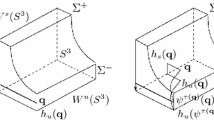Abstract
In the case of oscillatory motion in the problem of three bodies it is shown that ast→∞ the mutual distances between particles cannot separate faster thanCt 2/3 whereC is some positive constant. As bounding functions of time exist for the other classifications of motion in the three body problem, it follows in general that the mutual distances between particles is 0(t) ast→∞.
Similar content being viewed by others
References
Chazy, J.: 1922,Ann. Sci. École Norm. 39, 1–130.
Pollard, H.: 1966,Mathematical Introduction to Celestial Mechanics, Prentice-Hall, New York.
Author information
Authors and Affiliations
Rights and permissions
About this article
Cite this article
Saari, D.G. On oscillatory motion in the problem of three bodies. Celestial Mechanics 1, 343–346 (1970). https://doi.org/10.1007/BF01231138
Received:
Issue Date:
DOI: https://doi.org/10.1007/BF01231138




